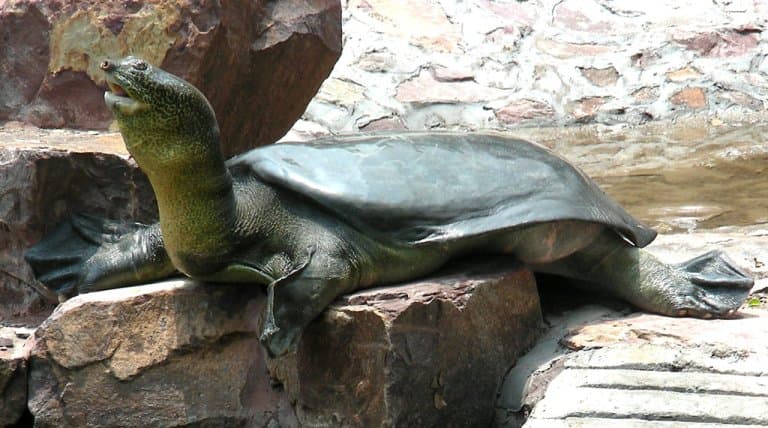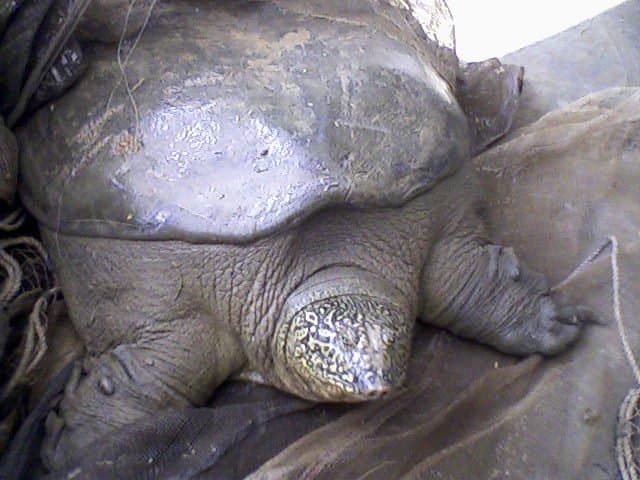Yangtze Giant Softshell Turtle Profile
It’s sometimes curious how an animal can be so historically revered by humans and yet entirely at risk of disappearing because of them. There’s a disconnect between what people say they believe and what their behaviour suggests is more important.
As it happens, the single most endangered animal known is one that was once said to be the form of a God, yet this legend wasn’t enough to protect it from being hunted for food, alternative medicine and hide.
The Yangtze giant softshell turtle’s story should remind us that words and legends are cheap, and that respect needs to be shown through actions. This species of freshwater turtle is one of the rarest animals on the planet and native to eastern and southern China, and northern Vietnam.

Yangtze Giant Softshell Turtle Facts Overview
| Habitat: | Muddy, deep lakes and rivers |
| Location: | Native to Eastern China, Northern Vietnam |
| Lifespan: | Over 100 years |
| Size: | Likely well over 1m (3ft) long |
| Weight: | Up to around 200kg (440 lb) |
| Colour: | Dark grey/green |
| Diet: | Fish, crabs, snails, frogs, aquatic vegetation |
| Predators: | Unknown |
| Top Speed: | Unknown |
| No. of Species: | 1 |
| Conservation Status: | Critically endangered / Likely Functionally Extinct (IUCN) |
The Yangtze giant softshell turtle is known known by a variety of different names – the Red River giant softshell turtle, the Shanghai softshell turtle, the speckled softshell turtle, and Swinhoe’s softshell turtle.
This turtle is one of, if not the biggest on earth, and despite this, it’s incredibly hard to spot. This is, in part, because there are hardly any left, but also by way of its shy and elusive nature.
This ugly-looking animal was once well adapted to live in the rivers, but widespread and unregulated habitat destruction coupled with rampant hunting for its various parts have reduced it to numbers you can count on one hand.
Only two males are known to exist, but conservationists are now in a race against time to find a female before her habitat is also destroyed.
Interesting Yangtze Giant Softshell Turtle Facts
1. They might be the largest freshwater turtle in the world
Sightings of this turtle are exceedingly rare, and records are still slim, so the average size and weight are skewed by the fact we only know the stats for about three of them.
But from these few individuals, it’s clear this is a massive turtle, and could well be the biggest freshwater turtle on Earth.
From the limited data, it’s thought this turtle can likely reach more than 200kg in weight, and spans over a meter in length, which is about the same length as the largest of the snapping turtles, but more than twice as heavy! 1

2. They’re extremely elusive
One great way to avoid detection is to become functionally extinct in the wild, and this species may well have done that already, but even before this, it was a hard animal to find.
Despite being enormous, these animals are very secretive, and the pig-like snout on the face of the animal goes some way to explaining why.
This large, leathery reptile would stay entirely submerged in muddy water most of the time, only coming up to breathe, and often only poking its snorkel-like nose out of the water to do so.
This has created a lot of difficulty for researchers and conservationists, who know little about the animal and are therefore lacking in useful information regarding how to save it.
3. They were turtle gods
In Vietnam, they were known well to the local peoples and show up in classic mythology for the region as deities.
It’s said Kim Qui was a god in the form of a Yangtze giant softshell turtle who showed up to help the Vietnamese overthrow their oppressive Chinese rulers. A lake in Hanoi is the site where the new Vietnamese emperor Lê Lợi returned his sword to the same god after securing independence
4. They’re one of the rarest animals on Earth
Despite being known to ancient lore, this turtle has been hunted to the verge of extinction. Other threats to the species have come from damming the river, destroying natural habitats and an altogether lacklustre approach to its protection through the legislature.
It has been a long time since any new turtles were seen in the wild, and of the three that were known to science, one has recently died. 2
5. There are two known turtles left
The only female of the trio was found floating about very much dead in April 2023, dooming the species to functional extinction unless another can be found.
Conservationists have spent almost two decades working on protecting and restoring its habitat, so the death comes as a huge blow to a last-ditch attempt at saving the species.
This might mean that the Yangtze giant softshell turtle is now the rarest and most endangered animal on the planet.
6. There might be more
But this is a historically shy and well-hidden animal. There’s no question the species is in dire straits, but the nature of its habitat and excellent camouflage means there could be some hope.
The saving of this species relies upon locating another female and desperately trying to protect its habitat before this one, too, expires.
These turtles are fantastic at hiding, so while the data suggests a dead end for this ancient lineage of turtles, there is a glimmer of hope among the conservation communities that another female can be found.
Habitats for this animal are disappearing fast, and without confirmed sightings, there will be no leverage for restricting its destruction, so it really is a race against time.
Efforts are further complicated by the fact that this is not a glamorous animal. The iconic Asian conservation mascots like pandas and tigers receive millions in support, but a pig-faced muddy reptile draws in significantly less through appeal alone.
7. One female could be all that’s needed
Another issue is the low genetic diversity, and in-breeding will play a huge role in the survival of this species, should it happen at all.
That brings up questions of whether a single female turtle will even be enough to repopulate the range with genetically healthy individuals.
But some researchers clearly think it will. A single female can lay up to 100 eggs in a year, but captive efforts in the past have shown that despite laying so many eggs, they can be entirely infertile.
As it stands, the future looks very bleak for the Yangtze giant softshell turtle. But it may only take a single female to turn the tide entirely. 3
Yangtze Giant Softshell Turtle Fact-File Summary
Scientific Classification
| Kingdom: | Animalia |
| Phylum: | Chordata |
| Class: | Reptilia |
| Order: | Testudines |
| Family: | Trionchidae |
| Genus: | Rafetus |
| Species: | Rafetus Swinhoei |
Fact Sources & References
- “Yangtze giant softshell turtle”, IGB.
- Jeremy Hance (2023), “Death of last female Yangtze softshell turtle signals end for ‘god’ turtle”, Mongabay.
- (2023), “Largest freshwater turtle species doomed to extinction after last female washes up dead”, Live Science.
